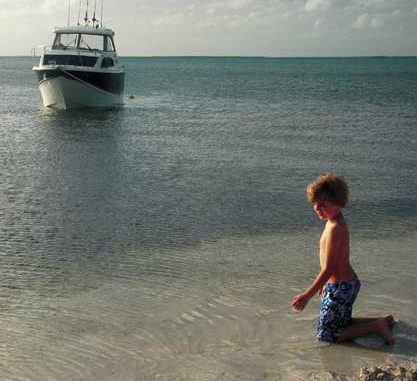
One minute we were enjoying a Memorial Day picnic on the beach, and the next we were up to our knees in mire, racing the tide to get enough of our boat to float to get us off the barrier island. The picnic went as planned, and once all the food was consumed, our party of five decided to walk off the meal with an exploratory trek around the island. I took a look at the anchored boat to make sure it was staying put in the gentle surf, hip deep and nose to the beach, thanks to an offshore breeze.
What I didn’t factor was the afternoon wind shift toward shore that, with the waves it generated, combined to swing the boat like a pendulum on its anchor line and wash it onto the sand. We allowed Ma Nature at least an hour to firmly ground the craft before returning to the scene of the stranding.
The semi-vee hull was still awash, and because I had tilted the engine up, the lower unit was clear of the sand, but the boat was firmly beached and barely “rock-able” by the time we discovered our plight.
Two hours of digging and pushing and at least one strained back later, we finally had the boat afloat, but not before employing the efforts of a fellow boater who was prepared and proficient at pulling boats in similar predicaments off the sand.
Because of the gentle slope of the beach, the Samaritan who recognized and responded to our situation could not get closer than about 40 yards to our craft and still have enough water under his hull for his prop to dig into. Fortunately, he carried a 100-yard coil of stout, ¾-inch double-braided line for just such occasions, he explained, after a failed attempt to pull his own boat free from a sandbar trying both 3/8-inch anchor line and a ski tow rope.
Deftly doubling the line through our port transom eye, he waded out to his own anchored boat and snapped a working end to each of his own boat’s two transom hooks. He hopped back aboard his deck boat, started it, and putting the engine in gear, he gently snubbed the connection tight, making sure both lines were under the same tension and his direction of pull directly into the wind and perpendicular to the beach.
Warning everyone but the two of us who were doing the rocking and the pushing at the bow of the boat to stand well clear, he throttled up, and with steady power soon pulled us free.
Accepting only a cold beverage in thanks as he departed, our Memorial Day saint had shown near textbook form when responding to our situation by:
• not putting his own boat in peril, by standing well off the shallows. He actually anchored his boat in deeper water and walked the hauling line in to us rather than motoring in close enough to toss us the tow tether. In doing so, he reduced the risk of damaging his own lower unit in the shallows and the chances of his own boat becoming grounded.
• assessing the stranding situation and determining it as “doable” based on the progress we had made, the wind and water conditions and his own equipment and experience. There was no cross breeze or current to fight and both boats’ centerlines would remain reasonably parallel to the direction of pull during the effort.
• pulling from the stern of his boat with the bow facing open water rather than backing his boat to pull us off. That allowed him to distribute the strain at two points on his transom rather than place the entire load on a single bow eye, which gave him better control of his own craft.
• tying off to transom eyes rather than deck cleats. Although any fitting is capable of giving way under strain, towing or lifting eyes placed on the transom are usually designed and installed with backing plates to accept a greater load than are topside cleats.
• using slow, steady power to pull the tow line snug and the boat off the sand. Sudden thrusts of power to attempt to yank a boat free can snap a line, break hardware, or both.
• having those not active in the effort to free the boat stand well aside, and those doing the pushing remaining as protected as possible, in the event a line snapped or a piece of hardware broke free.
We were lucky to have experienced, well-equipped help arrive, and our boat angled such that it pulled free with a minimal amount of effort (at least from the rescue boat …).
If you find your boat grounded and have any doubt about your ability to get yourself out of the stranding situation, even with the offer of help from fellow boaters, it is best to call for professional assistance.


